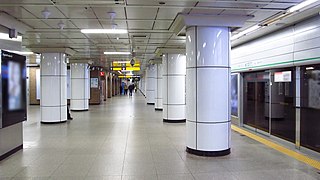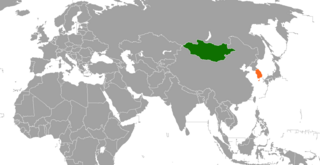Related Research Articles

Seoul National University is a public research university located in Seoul, South Korea. It is one of the SKY universities and a part of the Flagship Korean National Universities.

Gyeongju, historically known as Seorabeol, is a coastal city in the far southeastern corner of North Gyeongsang Province, South Korea. It is the second largest city by area in the province after Andong, covering 1,324 km2 (511 sq mi) with a population of 264,091 people as of December 2012. Gyeongju is 370 km (230 mi) southeast of Seoul, and 55 km (34 mi) east of Daegu. The city borders Cheongdo and Yeongcheon to the west, Ulsan to the south and Pohang to the north, while to the east lies the coast of the Sea of Japan. Numerous low mountains—outliers of the Taebaek range—are scattered around the city.

Korea Train eXpress (Korean: 한국고속철도), often known as KTX, is South Korea's high-speed rail system, operated by Korail. Construction began on the high-speed line from Seoul to Busan in 1992. KTX services were launched on April 1, 2004.

Kim Do-jin, professionally known as Won Bin, is a South Korean actor. He first gained wide popularity in 2000 after starring in the KBS's television series Autumn in My Heart. One of the most selective actors in the Korean entertainment industry, he has starred in only five films to date, Guns & Talks, Taegukgi, My Brother, Mother and The Man from Nowhere. He was Gallup Korea's Film Actor of the Year in 2010 and 2011.

Sadang Station is a station on the Seoul Subway Line 2 and Seoul Subway Line 4 in South Korea.
Human rights in South Korea are codified in the Constitution of the Republic of Korea, which compiles the legal rights of its citizens. These rights are protected by the Constitution and include amendments and national referendum. These rights have evolved significantly from the days of military dictatorship to the current state as a constitutional democracy with free and fair elections for the presidency and the members of the National Assembly.
Immigration to South Korea is low due to restrictive immigration policies resulting from strong opposition to immigrants from the general Korean public. However, in recent years with the loosening of the law, influx of immigrants into South Korea has been on the rise, with foreign residents accounting for 4.9% of the total population in 2019. Between 1990 and 2020, South Korea's migrant population has grown 3.896%, second highest level of growth in the world.

Jung District is one of the 25 districts of Seoul, South Korea.
Vietnamese people in Korea, also known as Vietnamese Koreans, have a history dating back to the 12th century. After the division of Korea and the Korean War, ethnic Vietnamese had various contacts with both North and South Korea. They are Vietnamese expatriates in Korean peninsular or Korean born-citizens were born of partially or full Vietnamese descent. In the latter, Vietnamese are the second-largest group of foreigners, after Chinese migrants.
Koreans in Iran have a history dating back to the 1970s, when South Korean labour migrants began flowing into the country. However, most returned home or moved on to other countries; as of 2011, only 405 Koreans lived in the country, according to the statistics of South Korea's Ministry of Foreign Affairs and Trade.
Koreans in Africa form a very small population, estimated at only 9,200 people in 2005, with almost half of these living in South Africa. South Korean nationals can be found in 49 countries of Africa, including the continent and its surrounding islands; they have established schools in 19 of those countries. They form a small part of the Korean diaspora.
Koreans in France numbered 29,367 individuals as of 2014, making them the 3rd-largest Korean diaspora community in Western Europe, according to South Korea's Ministry of Foreign Affairs and Trade.
Germans in Korea have a long history, though they have never formed a significant population.

North Koreans in Russia consist mainly of three groups: international students, guest workers, and defectors and refugees. A 2006 study by Kyung Hee University estimated their total population at roughly 10,000.
Koreans in Peru formed Latin America's seventh-largest Korean diaspora community as of 2011, according to the statistics of South Korea's Ministry of Foreign Affairs and Trade. They are relatively small in size compared to the other Asian communities in Peru.
Mongolians in the Czech Republic form one of the country's smaller ethnic groups. Although the workers from Mongolia comprised 3.6% of the foreign workforce as of 2008, the group has grown over the last decade and numbered 10,236 men and women holding Mongolian nationality by June 2020. By 2011 they had declined both in numbers and in relative size to other foreign populations, having been surpassed by Russians and Moldovans. However, the group began to resume its growth after 2014 once again. Currently, a large group of Mongolians reside in the town of Česká Lípa and its surrounding area.
Koreans in Guatemala form one of the newest and fastest-growing Korean diaspora communities in Latin America.

Mongolia–South Korea relations are foreign relations between South Korea and the Mongolia. Both countries established diplomatic relations on March 26, 1990. South Korea has an embassy in Ulaanbaatar. Mongolia has an embassy in Seoul.
Koreans in Mongolia form one of the Korean diaspora communities in Asia. They consist of both North and South Korean expatriates.

Okryu-gwan or Okryu Restaurant is a restaurant in Pyongyang, North Korea, founded in 1960. South Korea analyst Andrei Lankov describes it as one of two restaurants, the other being Ch'ongryugwan, which have "defined the culinary life of Pyongyang" since the 1980s, and a "living museum of culinary art".
References
- ↑ Number of foreigners in Korea up for 1st time in 20 months
- 1 2 3 "'Korean Dream' fills Korean classrooms in Mongolia", The Chosun Ilbo, 2008-04-24, archived from the original on 2008-09-23, retrieved 2009-02-06
- 1 2 "Mongolians, Koreans share ancient bonds", Taipei Times, 2003-10-13, retrieved 2007-08-17
- 1 2 3 "Sea Breeze Helps Korea's Mongolians Speak with One Voice", The Chosun Ilbo, 2005-03-29, archived from the original on 2008-05-29, retrieved 2007-09-05
- ↑ Han, Jae-hyuck (2006-05-05), "Today in Mongolia: Everyone can speak a few words of Korean", President Roh Moo-hyun: Summit Diplomacy, Republic of Korea: Office of the President, retrieved 2007-08-17
- ↑ 체류외국인 국적별 현황, 2013년도 출입국통계연보, South Korea: Ministry of Justice, 2009, p. 262, retrieved 2011-03-21
- ↑ Chae, Seong-jin (2003-10-10), 도심속의 "몽골 타워" [The "Mongol Tower" in the heart of the city], The Chosun Ilbo (in Korean), archived from the original on 2005-02-04, retrieved 2007-08-17
- ↑ Phillips, Simon (2007-06-19), "A Mongolian Migrant Worker's Story", Korea Times, retrieved 2007-08-17
- ↑ "No melting pot, but Seoul still flavoured with several dashes of migrant communities", Korea.net, 2006-12-19, retrieved 2007-08-17
- ↑ "A Little Corner of Overseas in Seoul", The Chosun Ilbo, 2007-04-05, archived from the original on 2007-04-10, retrieved 2007-08-17
- ↑ Koehler, Robert (2006-04-19), "The Silk Road Leads to Seoul: Dongdaemun's Central Asia Village and Namyangju's Mongolian Cultural Village", Seoul Magazine, archived from the original on 2007-06-15, retrieved 2007-08-17
- ↑ Sh., Batmonkh (2007-06-27), "13,000 Qualify to Enter Korea", UB Post, archived from the original on 2007-08-13, retrieved 2007-08-17
- ↑ "Chaos reigns in registration process", The Mongol Messenger, 2007-05-22, archived from the original on 2007-09-30, retrieved 2007-08-17
- ↑ "Asia Women Network Supporting Married Migrant Women's Human Rights" (PDF), Asian Workers News, p. 7, 2006-12-10, retrieved 2009-02-06
- ↑ "Mongolia". Autowini. Retrieved 28 March 2024.
- ↑ "Mongolians save the life of Korean Official", Mongolia-web.com, 2007-04-19, archived from the original on 2011-07-14, retrieved 2011-07-30
- ↑ 송화선 (2002-12-26), 몽골 아이들 '배움의 갈증 목말라요', Weekly Donga Magazine (in Korean), no. 365, pp. 66–67, retrieved 2011-07-31
- ↑ 김지은 (2011-02-10), 한예종·재한몽골학교, 다섯번째 '아트캠프', Nate News/Newsis (in Korean), retrieved 2011-07-30
- ↑ Park, Angela (2010-07-27), "Mongolian students face new challenges", Joongang Ilbo, retrieved 2011-07-30